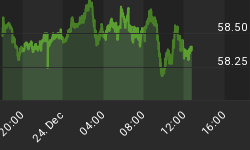We have been consistent in looking for lower prices in gold since 2012, and until recently that has been an unpopular position with (seemingly) everybody except our subscribers. Now that we are approaching the time and price area where we believe gold actually will put in a low, we have noticed an increase in the rate of technical analysis articles calling for prices to fall considerably lower. That sentiment itself might be considered a trading signal, but there are several solid technical reasons why gold should find support soon, even as some bulls have begun capitulating to the idea of another leg down.
Even though we make extensive use of Elliott wave analysis, our starting point with any market is usually much simpler - basic chart geometry. Correct placement of channels, forks, and trend lines helps reveal the most likely wave count scenarios.
Throughout its decline, gold has behaved as it should with respect to chart geometry. This can be seen on the monthly chart below and almost equally well on the later weekly chart. In particular, the monthly chart shows how the downward impulsive third wave [iii] broke out of the channel, and the subsequent corrective fourth wave [iv] went sideways to re-enter the channel and test important channel resistance.

In the decline that we believe is a developing fifth wave [v], price is so far recognizing the boundaries of the smaller channel shown on the weekly chart below.

Having a good cycle-detection tool also helps clarify the forecast. The currently dominant 62-week cycle for gold suggests that price should put in a durable low soon. The bottom of the cycle will be during the first half of November, although one usually cannot expect pinpoint precision from such things. Right now, the most important factor governing price is the need for the wave count to finish. A test of the lower boundary of the weekly channel near the cycle low would be ideal in terms of geometry, cycles, and probably the Elliott wave structure.
In an expanded version of this article at our website, we present some support levels that traders might consider as targets for the fifth wave, and we offer some things to watch that would suggest that a low has already been put in (an alternate scenario).
If price follows the main scenario that has been set out here, an autumn low should produce a bounce that will last 6 months or longer. Our bigger-picture count suggests that price will again visit the present area, and perhaps lower, sometime in 2016 or 2017. However, the big picture is subject to refinement as the structure develops. The likely trades are of shorter duration - months, not years.
















